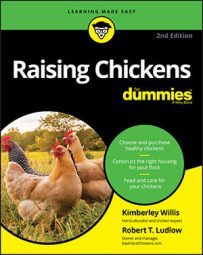Home flock owners often want chickens that will give them a decent amount of eggs and also be meaty enough so that they can use excess birds as meat birds. The eggs taste the same; you just don’t get as many as you do from laying breeds.
The meat tastes the same if you raise the dual-purpose birds like you raise meat birds, but their breasts are smaller and the birds grow much more slowly. Some of the birds classified as dual-purpose breeds in the following list were once considered to be meat breeds until the Cornish X Rock cross came along. The figure illustrates common dual-purpose breeds, including these breeds:
![[Credit: Illustration by Barbara Frake]](https://www.dummies.com/wp-content/uploads/470034.image0.jpg)
Barnevelders: The Barnevelder is an old breed that’s making a comeback because of its dark brown eggs. Barnevelders are fair layers and are heavy enough to make a good meat bird, although they’re slow growing. They come in black, white, and blue-laced, as well as other colors. These calm, docile birds are fluffy looking and soft feathered.
Brahmas: The Brahma is a large, fluffy-looking bird that lays brown eggs. Brahmas are good sitters and mothers and, as such, are often used to hatch other breeds’ eggs. They’re good meat birds, but they mature slowly. Their feet are feathered, and they come in several colors and color combos. They withstand cold weather well, and they’re calm and easy to handle.
Orpingtons: Orpingtons deserve their popularity as a farm breed. They’re large, meaty birds, and they’re pretty good layers of brown eggs. They’ll also sit on eggs and they’re good mothers. Buff or golden-colored Orpingtons are the most popular, but they also come in blue, black, and white. These birds are calm and gentle. They can forage pretty well but don’t mind confinement.
Plymouth Rocks: These birds are an excellent old American breed, good for both eggs and meat. White Plymouth Rocks are used for hybrid meat crosses, but several other color varieties of the breed, including buff, blue, and the popular striped black-and-white birds called Barred Rocks, make good dual-purpose birds. They’re pretty good layers of medium-size brown eggs, they’ll sit on eggs, and they’re excellent home meat birds. They’re usually calm, gentle birds, good for free-range or pastured production.
Wyandotte: These large, fluffy-looking birds are excellent as farm flocks. They’re pretty good layers of brown eggs (some will sit on eggs), and they make excellent meat birds. They come in several colors, with Silver Laced and Columbian being the most popular. Wyandottes are fairly quick to mature, compared to other dual-purpose breeds. Most are docile, friendly birds.
Turken/Transylvanian Naked Neck: With an odd name like this, you may think this breed was crossed with a turkey — but it isn’t. This breed comes in many colors, but the distinguishing feature is a lack of feathers on the neck.
The genes that make the neck bare also contribute to a good-sized, meaty breast area in the chicken and make it easier to pluck. These birds are fairly good layers of medium to large light brown eggs. While they may look ugly, Turkens are calm and friendly birds.

